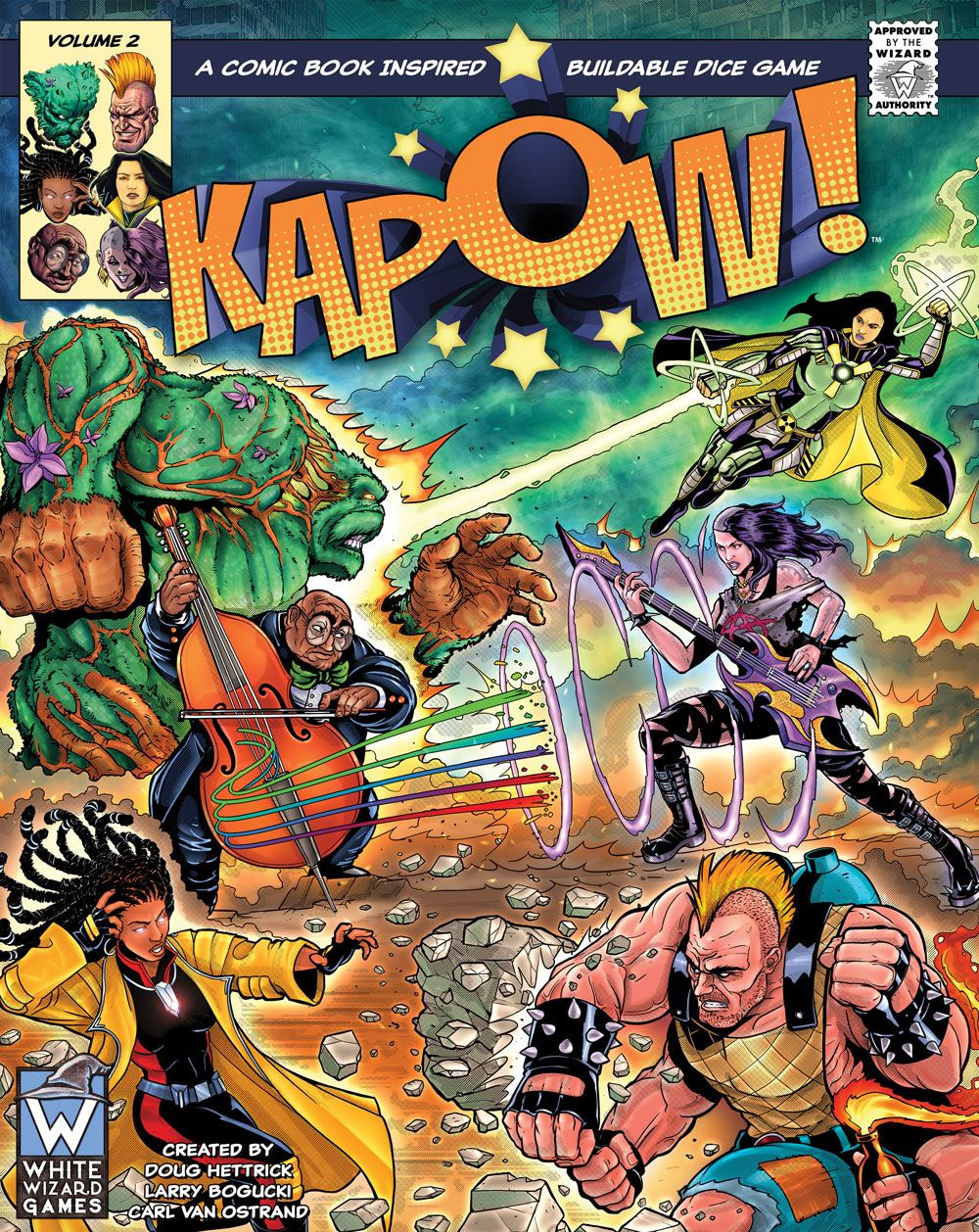
 Superheroes and dice chucking can be a lot of fun, but those themes and mechanisms aren’t always implemented well in such games. In KAPOW!, heroes and villains duke it out in the streets using a pool of dice to power special abilities that will determine whether good or evil wins the day. Does this game manage to succeed on the promise of engaging gameplay and a cool theme? Tune in to find out.
Superheroes and dice chucking can be a lot of fun, but those themes and mechanisms aren’t always implemented well in such games. In KAPOW!, heroes and villains duke it out in the streets using a pool of dice to power special abilities that will determine whether good or evil wins the day. Does this game manage to succeed on the promise of engaging gameplay and a cool theme? Tune in to find out.
KAPOW! Volume 2 is a pool-building, dice-crafting game from Wise Wizard Games designed by Doug Hettrick, Larry Bogucki, Carl Van Ostrand, and Rob Dougherty for 1-4 players that plays in about 20-40 minutes.
Gameplay Overview:
In a standard 1 vs. 1 game of KAPOW!, each player takes on the role of either a comic book Hero or Super Villain. Players get a screen, a player board, a character board, and a health tracker, plus some starting dice. The goal is to knock out your opponent by building a pool of dice that will activate various attacks, abilities, and power ups.

Each round has four phases, and play continues until there is a victor. In Phase 1, players simultaneously roll their dice, placing them in boxes on their player and character boards to select abilities for activation. Most actions will be taken later, but a few immediate abilities can be applied at this time for things like rerolls or healing. Dice selection takes place secretly behind the player screens, which have quick references printed on them detailing things like the round structure and die-face distributions.
The meat of the round plays out in Phase 2, where players will attack and defend. In turn order, a player will remove their screen to reveal which attack abilities they’ve chosen. Attack damage is calculated by combining one base attack with any number of attack kickers and multiplying that value by any one activated attack multiplier. The defender then has an opportunity to apply any defensive abilities they may have selected, which follow the same formula of adding base defense, defense kickers, and defense multipliers. If the defense total is higher than the attack, no damage is dealt. Otherwise, the difference between the attack and defense values is applied as a loss of Health to the defender. Many defensive abilities also allow the player to gain die faces that can later be attached to their Action dice.

In Phase 3, players can apply Power Up abilities that they’ve activated with dice. These effects mostly involve adding more Trait dice and Action die faces. Trait dice are colored dice with differing distributions of the icons needed to activate abilities on your boards. For instance, shields (Toughness) will help to trigger defend abilities and fists (Might) translate to stronger attack options. Depending on what kinds of abilities you want to emphasize, you’ll be searching for particular icons when rolling dice, so it’s important to build your pool carefully.
During Phase 4, players will retrieve dice from their boards and craft their Action dice. An Action die has removable faces so that players can customize each one according to their needs. For example, the Spore character has several abilities that trigger off of blue X-Factor die faces. In order to make sure you can activate Spore’s powerful effects, you might craft an Action die with only X-Factor and Wild faces to guarantee the icon comes up each round. Any newly-acquired die faces can be attached to your Action dice during this phase, and all faces can be freely swapped or rearranged at this time.
Play continues following this round structure until one of the players is reduced to 0 Health, thus crowning a winner.

Game Experience:
Being able to craft the powers of your heroes and villains makes KAPOW! a fun dueling game that doesn’t just devolve into “whose rolls are better?” Sure, luck does factor into whether you can pull off your strongest abilities, but being able to build your dice pool means that players have more agency over the probabilities. If you want your hero to consistently have access to a particular icon, then you can collect Trait dice that favor the corresponding face. Or, you could just craft an Action die that will yield that symbol 100% of the time you roll it.

KAPOW! Volume 2 is a standalone game that introduces six new characters, three Heroes, and three Villains into the KAPOW! universe. If you’re familiar with Volume 1, the gameplay is pretty much the same, so there are no major mechanical differences between the two sets. A few abilities are unique to characters in Vol. 2, such as multiple attacks; for example, Fuse’s Molotovs power allows him to make three base attacks, adding kickers and multipliers to each attack. So, if you’re looking to get into the game, purchasing either Vol. 1 or Vol. 2 is a viable route and your choice really just boils down to which Heroes and Villains look more interesting to you. If you already have Vol. 1, then it’s essentially a question of whether you want more characters to choose from.
Another reason to own both sets is that having two base games enables 2 vs. 2 play, turning KAPOW! into a team-up game. Combined Health is tracked for each team as a whole and there are some special team abilities that can be used to coordinate during battle. This game mode obviously offers a way for a larger gaming group to play together, but doesn’t dramatically affect the way a session of KAPOW! plays out. You’re still rolling dice, activating abilities, and trying to whittle away your opponents’ health. Having a team’s health combined is a smart move as it prohibits scenarios where one side gangs up on a single opponent to knock them out of the match, then focus fire on a lone defender. However, intelligent tactical play can be rewarded if a team realizes that one of their opponents has weaker defenses and decides to deliver most attacks in that direction. So, if your group has four players, KAPOW!’s 2 vs. 2 mode will provide an engaging option for team battle.
There are also rulesets available for solo and co-op play, both of which integrate an AI opponent mechanism. The flip side of each character board has a chart of special abilities that are triggered by going from top to bottom and placing the AI’s dice on any powers that it is able to activate. It’s a fairly simple bot to run, but still manages to provide a reasonably formidable opponent to go up against.
Final Thoughts:
KAPOW! Volume 2 is a lot of fun, with plenty of variety provided by the Heroes and Villains available, particularly when combined with Vol. 1 for a total of 12 character options. Plus, there’s a good deal of replay value built in given the different ways you can build your dice pool and craft the Action dice. You might want to develop a heavily defensive character with explosive attacks in one game, or focus on one that steadily deals consistent damage to wear down your opponent in another play. The flexibility provided by the game grants a decent amount of agency and choice while keeping the basic ruleset and mechanisms straightforward and simple.
Whether you’re new to KAPOW! or you’ve got the first set already, Volume 2 provides plenty of engaging gameplay and is worth taking a look.
Final Score: 4 Stars – A solid comic book-themed dice game that lets players craft their character’s power set.
 Hits:
Hits:
• Character powers provide variety
• Pool building and dice crafting enhance agency
• Low rules overhead and plays quickly
• High quality components
Misses:
• Not a lot of options for modifying bad rolls
• Removing and attaching die faces could feel fiddly for some









